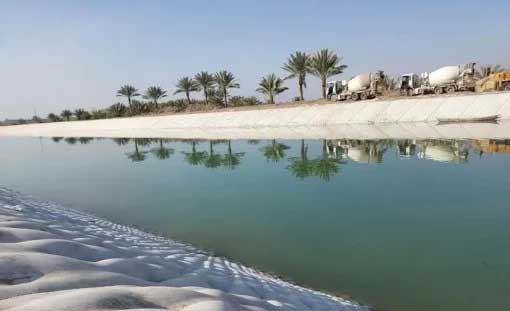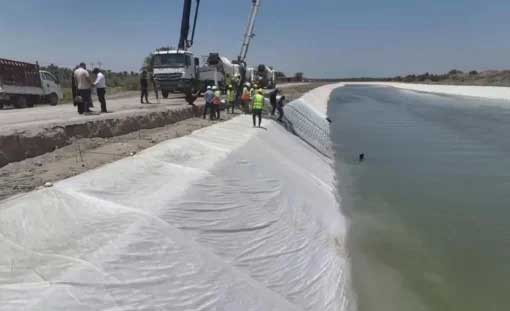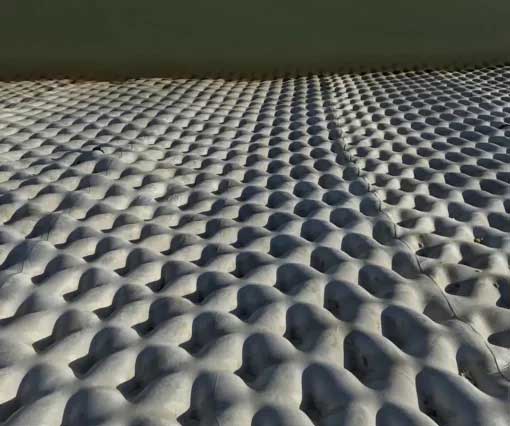Fabric Formed TEXLYPS

The TEXLYPS concrete mattress, with cell sizes ranging from 10 to 60 cm and a width of up to 4 meters, is made from polyester, polypropylene, or polyamide yarns. The cell size can be adjusted based on the project site's design requirements. It is used to prevent soil erosion, mud formation, and to protect pipelines or bridge pillars exposed to water. A specific type of this product, called ENFP, is designed for use along roadsides and urban canals, allowing for vegetation planting, which not only stabilizes slopes but also creates a green, natural environment.
Advantages of the TEXLYPS Concrete Mattress System
The TEXLYPS concrete mattress eliminates the need for formwork and reinforcement, as the mattress’s cells serve as a mold for the concrete, and the fibers connecting the upper and lower layers enhance the tensile strength of the concrete. This eliminates the costs of formwork and reinforcement while significantly increasing construction speed.

Flexibility
The flexibility of the TEXLYPS concrete mattress creates a resistant layer against uneven settlements during operation, whereas other products may crack under such conditions.
Tensile Strength
The high tensile strength of the woven geotextile used in the TEXLYPS concrete mattress ensures a permanent system with no need for periodic maintenance. Additionally, the geotextile’s tensile strength prevents cracking due to concrete shrinkage, a common issue in traditional concrete linings where shrinkage cracks are nearly unavoidable.

The system allows boats or marine equipment to dock alongside the lining. Due to the customizable roll dimensions, it can be used in constructing ponds, winding canals, or recreational complexes with specific applications. The TEXLYPS concrete mattress can be installed underwater and in high-flow river conditions, a feature not offered by other geotextile or armor systems.
One of the most significant advantages of the TEXLYPS concrete mattress is its resistance to corrosion and erosion. The geotextile’s lack of chemical reaction with environmental elements or fluids in contact with it protects the concrete within the mattress, significantly extending the system’s lifespan. In contrast, similar products suffer from corrosion and erosion due to direct exposure of concrete to environmental factors.

Installation and Execution Process
The TEXLYPS concrete mattress can be installed underwater and is far more economical, time-efficient, and durable compared to traditional methods such as stone masonry, riprap, or concrete pouring.
Installation Method for TEXLYPS Concrete Mattress
The TEXLYPS concrete mattress is easily transportable by workers or light vehicles. The installation site is first leveled, and typically, a layer of non-woven geotextile is placed underneath. The TEXLYPS concrete mattress panels are connected at the site to form a unified system.

Concrete pumping openings are either pre-installed at the factory or marked and cut on-site for pumping. Concrete with specific properties is pumped into the TEXLYPS concrete mattress. The execution speed depends on the concrete batching setup and site preparation. With proper coordination, up to 300 square meters per day can be covered using this method.
The TEXLYPS concrete mattress can be installed on slopes of 35 to 45 degrees with soil compaction of 90 to 95%. If steeper slopes are required, a reinforced soil system is recommended for slope stabilization.
Applications of the TEXLYPS Concrete Mattress System
- Sea coasts, streams, canals, rivers, lakes, water reservoirs, anchorages, ports, and docks
- Protection of oil and gas pipelines and bridge pillars exposed to water flow
- Cushions for controlling erosion on embankments and steep slopes
- Cushions for water storage reservoirs
- Maintenance of pile caps and erosion control for bridges
- Construction of woven geotextile packages for underwater concrete pouring projects
- Specific designs for protecting and controlling buoyancy forces on underwater pipelines
- Providing waterproofing designs and erosion control for underwater concrete walls
- Hydraulic erosion control for canal linings, culverts, rivers, and coasts
- Riverbanks and streams where vegetation can be planted to preserve the environment


